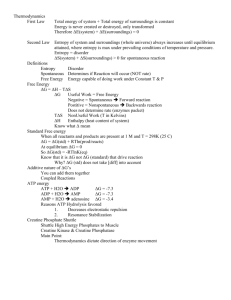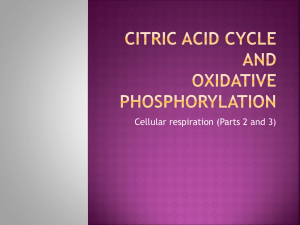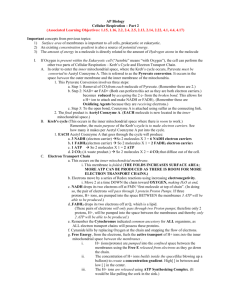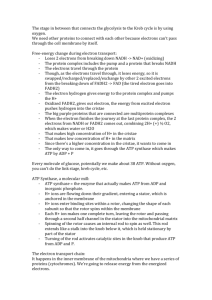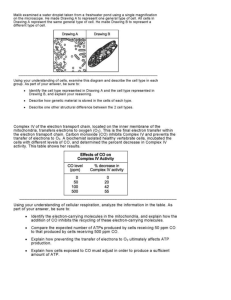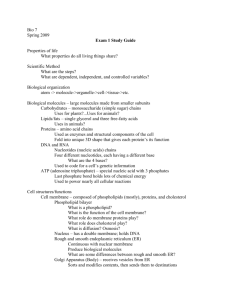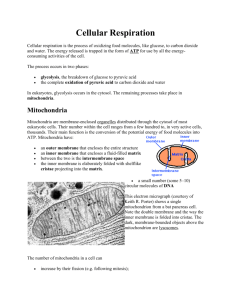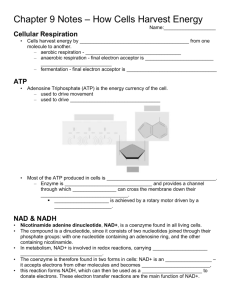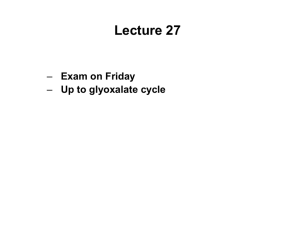Chapter 17 Electron Transport and Oxidative Phosphorylation The
advertisement
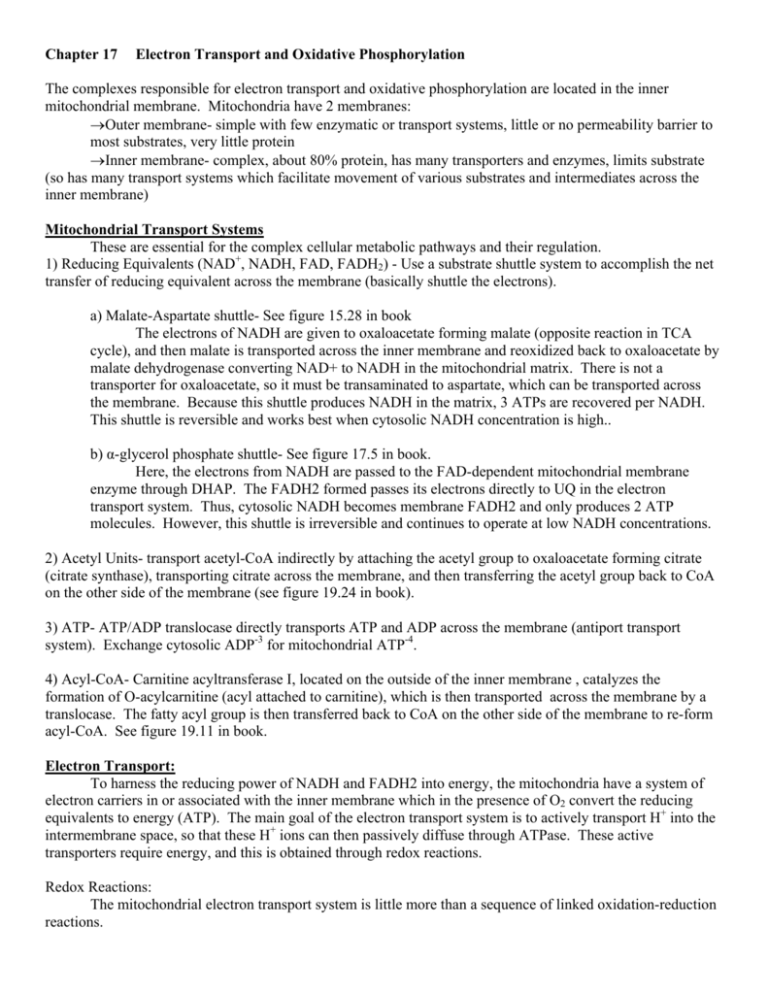
Chapter 17 Electron Transport and Oxidative Phosphorylation The complexes responsible for electron transport and oxidative phosphorylation are located in the inner mitochondrial membrane. Mitochondria have 2 membranes: →Outer membrane- simple with few enzymatic or transport systems, little or no permeability barrier to most substrates, very little protein →Inner membrane- complex, about 80% protein, has many transporters and enzymes, limits substrate (so has many transport systems which facilitate movement of various substrates and intermediates across the inner membrane) Mitochondrial Transport Systems These are essential for the complex cellular metabolic pathways and their regulation. 1) Reducing Equivalents (NAD+, NADH, FAD, FADH2) - Use a substrate shuttle system to accomplish the net transfer of reducing equivalent across the membrane (basically shuttle the electrons). a) Malate-Aspartate shuttle- See figure 15.28 in book The electrons of NADH are given to oxaloacetate forming malate (opposite reaction in TCA cycle), and then malate is transported across the inner membrane and reoxidized back to oxaloacetate by malate dehydrogenase converting NAD+ to NADH in the mitochondrial matrix. There is not a transporter for oxaloacetate, so it must be transaminated to aspartate, which can be transported across the membrane. Because this shuttle produces NADH in the matrix, 3 ATPs are recovered per NADH. This shuttle is reversible and works best when cytosolic NADH concentration is high.. b) α-glycerol phosphate shuttle- See figure 17.5 in book. Here, the electrons from NADH are passed to the FAD-dependent mitochondrial membrane enzyme through DHAP. The FADH2 formed passes its electrons directly to UQ in the electron transport system. Thus, cytosolic NADH becomes membrane FADH2 and only produces 2 ATP molecules. However, this shuttle is irreversible and continues to operate at low NADH concentrations. 2) Acetyl Units- transport acetyl-CoA indirectly by attaching the acetyl group to oxaloacetate forming citrate (citrate synthase), transporting citrate across the membrane, and then transferring the acetyl group back to CoA on the other side of the membrane (see figure 19.24 in book). 3) ATP- ATP/ADP translocase directly transports ATP and ADP across the membrane (antiport transport system). Exchange cytosolic ADP-3 for mitochondrial ATP-4. 4) Acyl-CoA- Carnitine acyltransferase I, located on the outside of the inner membrane , catalyzes the formation of O-acylcarnitine (acyl attached to carnitine), which is then transported across the membrane by a translocase. The fatty acyl group is then transferred back to CoA on the other side of the membrane to re-form acyl-CoA. See figure 19.11 in book. Electron Transport: To harness the reducing power of NADH and FADH2 into energy, the mitochondria have a system of electron carriers in or associated with the inner membrane which in the presence of O2 convert the reducing equivalents to energy (ATP). The main goal of the electron transport system is to actively transport H+ into the intermembrane space, so that these H+ ions can then passively diffuse through ATPase. These active transporters require energy, and this is obtained through redox reactions. Redox Reactions: The mitochondrial electron transport system is little more than a sequence of linked oxidation-reduction reactions. NAD+ +2H+ +2e- →NADH + H+ FAD +2H+ +2e- → FADH2 1/2O2 + 2H+ +2e- → H2O Eo=-0.32 V Eo= -0.22V Eo=+0.82 V NADH +H+ +1/2O2 →NAD+ +H2O ΔE=0.82 + 0.32= +1.14V spontaneous ΔG=-nFΔEo = 2(96.5 kJ/V-mole)(1.14V)= -220kJ (ATP 50 kJ/mole) The electron transport system is set up as a series of redox reactions in 4 different complexes to yield the same overall reaction as above. 1) Complex I (NADH dehydrogenase) This complex transfers a pair of electrons from NADH to coenzyme Q (UQ). The complex involves more than 30 polypeptide chains, one FMN, and as many as 7 Fe-S clusters. NADH transfers 2 electrons, but Fe-S centers are one electron transfer agents. So the FMN accepts the 2 electrons, then transfers them one at a time to the Fe-S centers. Then, 2 electrons are transferred to coenzyme Q, which is a mobile electron carrier. Coenzyme Q carries the electrons to complex III. Complex I contains an active H+ transporter. Reduced and oxidized forms of coenzyme Q 2) Complex II (Succinate dehydrogenase) Same enzyme as in the TCA cycle. It contains FAD covalently bound to a His residue and 3 Fe-S centers. FADH2 transfers its electrons to the Fe-S centers, which pass them on to UQ. The free energy change for these reactions is not sufficient to transport H+ ions. 3) Complex III (coenzyme Q-cytochrome c reductase) Coenzyme Q passes its electrons to cytochrome c1. Contains 3 different cytochromes and an Fe-S protein. The passage of electrons through complex III generates enough energy to actively transport H+ ions into the intermembrane space. The electrons are passed to cytochrome c (the only water soluble cytochrome) which is loosely associated with the inner mitochondrial membrane. 4) Complex IV (cytochrome c oxidase) Cytochrome c delivers its electrons to complex IV. Complex IV contains two heme centers (cytochromes a and a3) and two copper atoms (cycle between Cu+ and Cu+2 states). The electrons are shuttled through complex IV to O2, the final electron acceptor. Reduction of one oxygen molecule requires the passage of four electrons-one at a time. This complex also contains an active H+ ion transporter. Cytochromes: Proteins characterized by the presence of an iron-containing heme group bound to the protein. Participate in one electron redox reactions (Fe+2⇔Fe+3). Cytochromes are named on the basis of α band of their absorption spectra and type of heme group. These heme is linked to the protein through Cys, Met, or His residues. Iron-Sulfur centers: Fe+2⇔Fe+3 ATP synthase (F1F0-ATPase) Made up of 2 complexes-F1 and F0. The F1 unit is water soluble and consists of five polypeptide chains in the ratio α3β3γδε. The β subunits contain a binding site for ADP and contain the catalytic sites for ATP synthesis. The γ subunit forms a link between F1 and F0. The F0 unit is hydrophobic and forms the transmembrane channel through which protons move to drive ATP synthesis. As protons passively diffuse through ATPase, conformational changes occur in the enzyme resulting in the binding of substrates (ADP and Pi) on ATP synthase, ATP synthesis, and the release of products (ATP). Inhibitors of Oxidative Phosphorylation Name Function Site of Action Rotenone –insecticide, fish-kill, prevents reduction of UQ e- transport inhibitor Complex I e- transport inhibitor Complex I Demerol-widely prescribed painkiller e-transport inhibitor Complex I Antimycin A-antibiotic, blocks electron transfer from UQ to cytochrome b e- transport inhibitor Complex III Cyanide-binds tightly to Fe+3 of cytochrome a3 e- transport inhibitor Complex IV Carbon Monoxide-binds tightly to Fe+2 form of cytochrome a3 e- transport inhibitor Complex IV Amytal-barbituate, prevents reduction of UQ Azide- binds tightly to Fe+3 of cytochrome a3 e- transport inhibitor Complex IV 2,4,-dinitrophenol Uncoupling agent transmembrane H+ carrier Pentachlorophenol Uncoupling agent transmembrane H+ carrier Oligomycin Inhibits ATP synthase OSCP fraction of ATP synthase Note: Oligomycin inhibits ATP synthase, which will result in the inhibition of most all cellular respiration. 2,4DNP results in an increase in cellular respiration with no ATP production.
